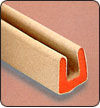EMI/RFI Shielding

What is EMI/RFI Shielding?
EMI/RFI shielding is designed to protect electronic equipment from harmful electromagnetic interference (EMI) and radio frequency interference (RFI). EMI/RFI disturbances can destroy or disrupt electrical circuits, making shielding a requirement for a wide range of electronic equipment.
Shielding is the practice of reducing or blocking interference in a space with barriers made of conductive or magnetic materials. EMI/RFI shielding is typically applied to electronic enclosures in one of two ways:
EMI/RFI gaskets create a conductive path along seams and openings in an enclosure. These gaskets establish smooth current flow and prevent destructive radiation from interfering with performance by completing a Faraday cage around the electronics. Conductive shielding gaskets can be made from many materials, including plastic, foam, metals, and elastomers.
EMI/RFI coating, typically Copper- or Nickel-based ink, can be sprayed onto the inside of the enclosure. Once sprayed and cured, the EMI/RFI coating produces a continuous conductive layer of metal — which can be electrically connected to the chassis ground of the equipment to achieve effective shielding.
How Does EMI/RFI Shielding Work?
EMI/RFI shielding has two primary functions:
Isolate sensitive electronics from sources of interference
Reduce EMI/RFI leakage into or out of a product enclosure
Through the use of shielding gaskets, the above functions are accomplished by plugging gaps between mating enclosure surfaces — preventing EMI/RFI from entering or exiting.
Elastomeric Materials Used in EMI/RFI Shielding Gaskets
When producing shielding gaskets for electronic applications, material is a key performance factor. Below are three examples of elastomeric materials used in EMI/RFI shielding gaskets — each of which offers unique properties for certain applications and operational environments.
Silicone EMI Gaskets
Silicone is an ideal gasket material because it offers resistance to high and low temperatures — as well as excellent tensile strength, compression set, and tear strength. This long-lasting material is also resistant to aging, fire, water, ozone, chemicals, and fungal growth. Generally, Silicone EMI/RFI shielding gaskets will meet the performance requirements for most applications and industries. However, EPDM or Fluorosilicone may be considered for more demanding environments.
EPDM EMI Gaskets
Ethylene Propylene Diene Monomer (EPDM) Rubber has a higher tensile strength than silicone. EPDM also functions well in high and low temperatures, and offers resistance to abrasion, oxidation, ozone, UV, acids, alkalis, water, and harsh weather conditions. The properties of EPDM make it ideal for outdoor environments, military applications, and other complex settings.
Fluorosilicone EMI Gaskets
Fluorosilicone is resistant to oil, fuel, chlorinated and aromatic hydrocarbons, UV, and ozone. It also features a good compression set and can perform well over a broad range of temperatures. Because of their material properties, Fluorosilicone shielding gaskets are popular for aerospace and military electronics as well as other demanding applications.
Dual Elastomer EMI Gaskets
Dual elastomer gaskets can create highly conductive EMI/RFI shielding gaskets that maintain their mechanical integrity long-term. Dual elastomer gaskets incorporate performance characteristics not commonly found in other forms of shielding gaskets. Advantages of dual elastomer EMI gaskets include:
Continuously extruded high-strength Silicone Rubber core
Co-extruded highly conductive metal-filled Silicone outer layer
Extremely high shielding effectiveness
Environmental sealing
No compression set
Low compression force
Extreme environment and abrasion resistance
Simple installation process


Advantages of EMI/RFI Shielding
Advantages of EMI/RFI shielding gaskets include:
Broad environmental protection (NEMA, IP, wind-driven rain, immersion, etc.)
Consistent attenuation performance (even under full compression)
Easier termination
Excellent conductive properties
Extended galvanic protection
Manufacturing flexibility
More resilient inner cores that do not contain or accrue metal fillers
Single-unit EMI seals (weatherproofing)
Silver conductive material limited to only a thin, outer membrane (reducing cost)
Superior compression and aging properties
Very low compressive forces
EMI/RFI Shielding Materials
The most common materials for producing EMI/RFI shielding gaskets are the following:
Conductive metal-filled elastomers such as Silicone, EPDM, and Fluorosilicone
Beryllium Copper
Wire mesh
Clad foam

EMI/RFI Shielding Applications
EMI/RFI shielding gaskets are used in a wide range of industries and products. Some examples include:
Aerospace: ESD dust caps, avionics, harsh-environment seals and gaskets
Defense: MIL-SPEC electrical conductivity, military weapons systems, communications devices, nuclear / biological / chemical products
Industrial: Shielded connector seals, office products, dairy transport tubing, thermal interface materials
Medical: Diagnostic equipment, instrumentation, enclosure bezels, food-grade O-rings, sterilized devices
Technology: Smartphones, tablets, computers, data processing, high-speed electronics, cellular / telecom base stations
Transportation: Automotive systems, navigation controls, shock absorption parts
.png)





























